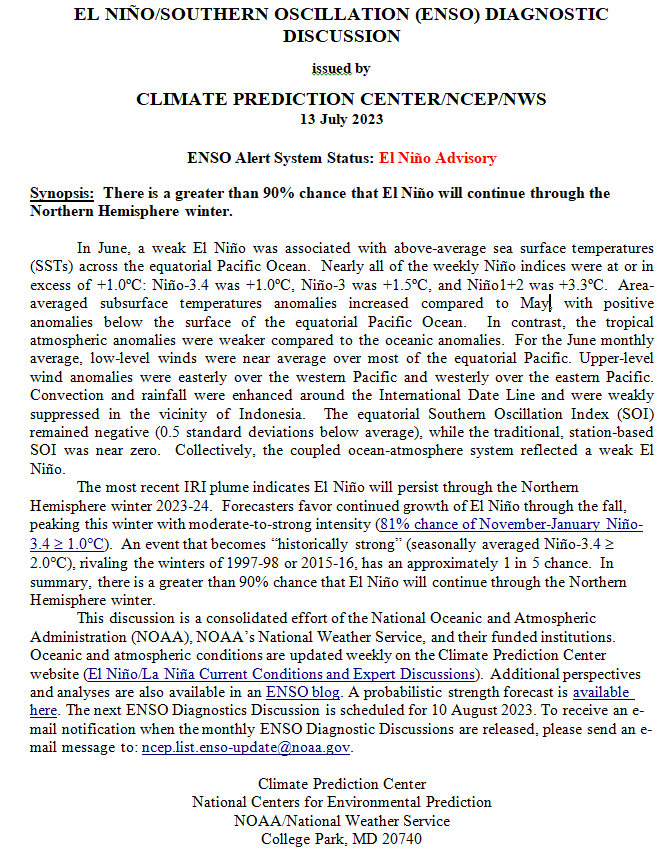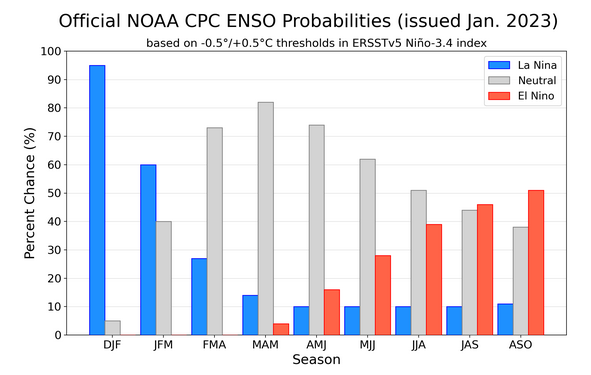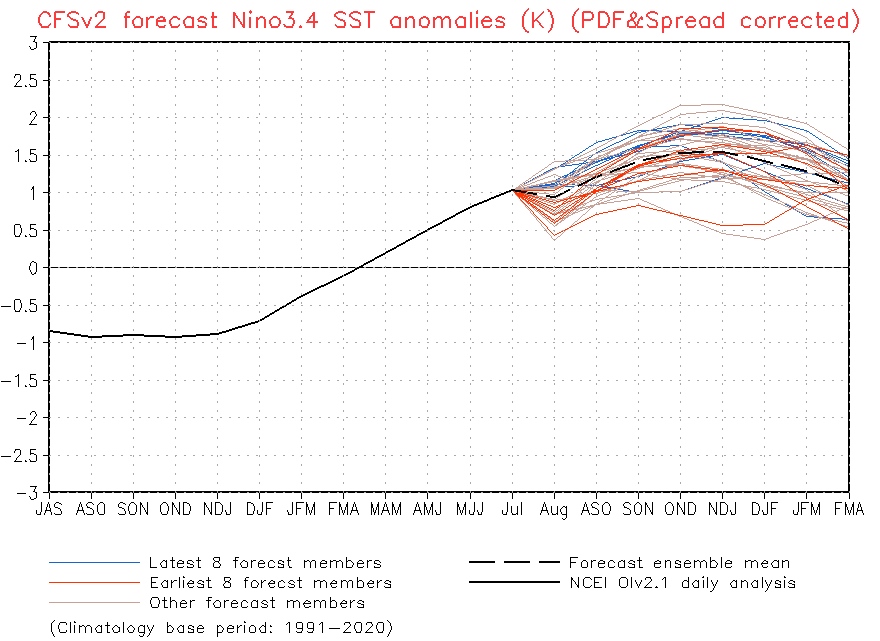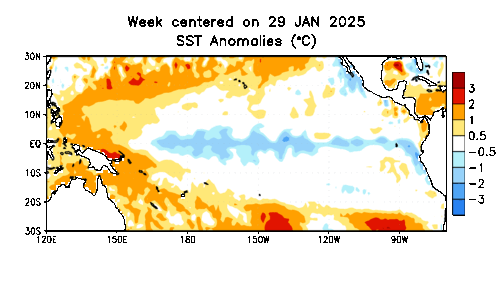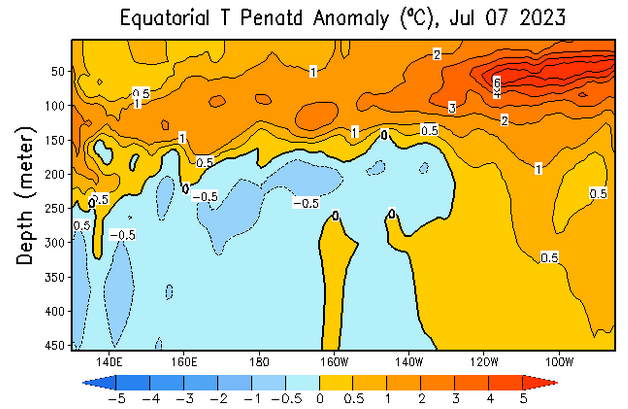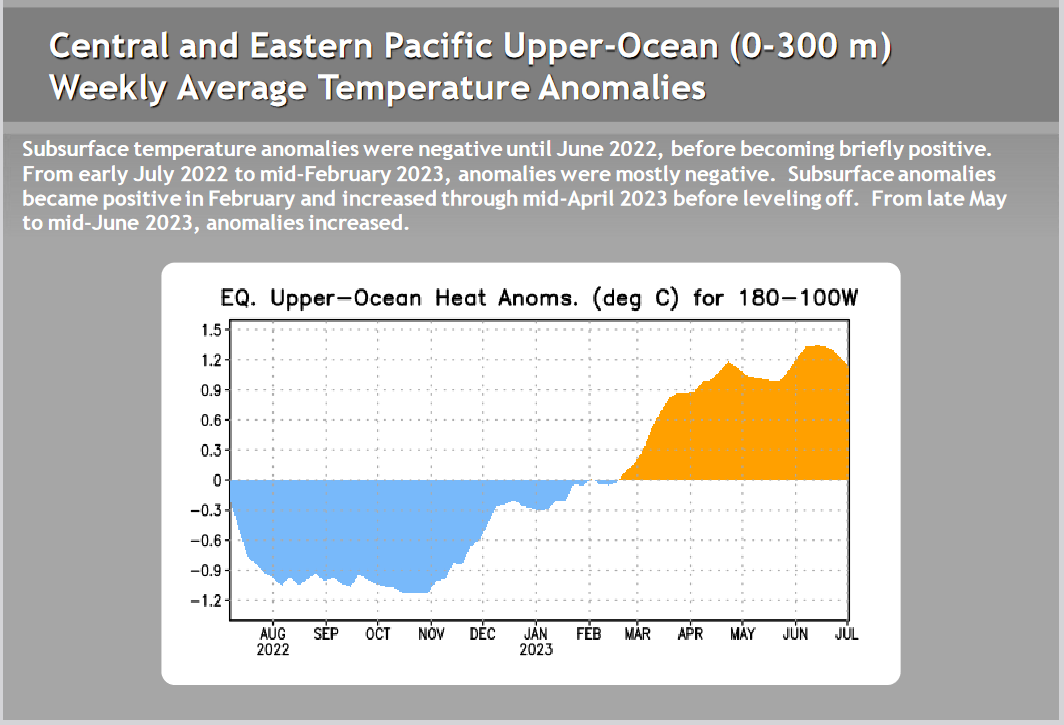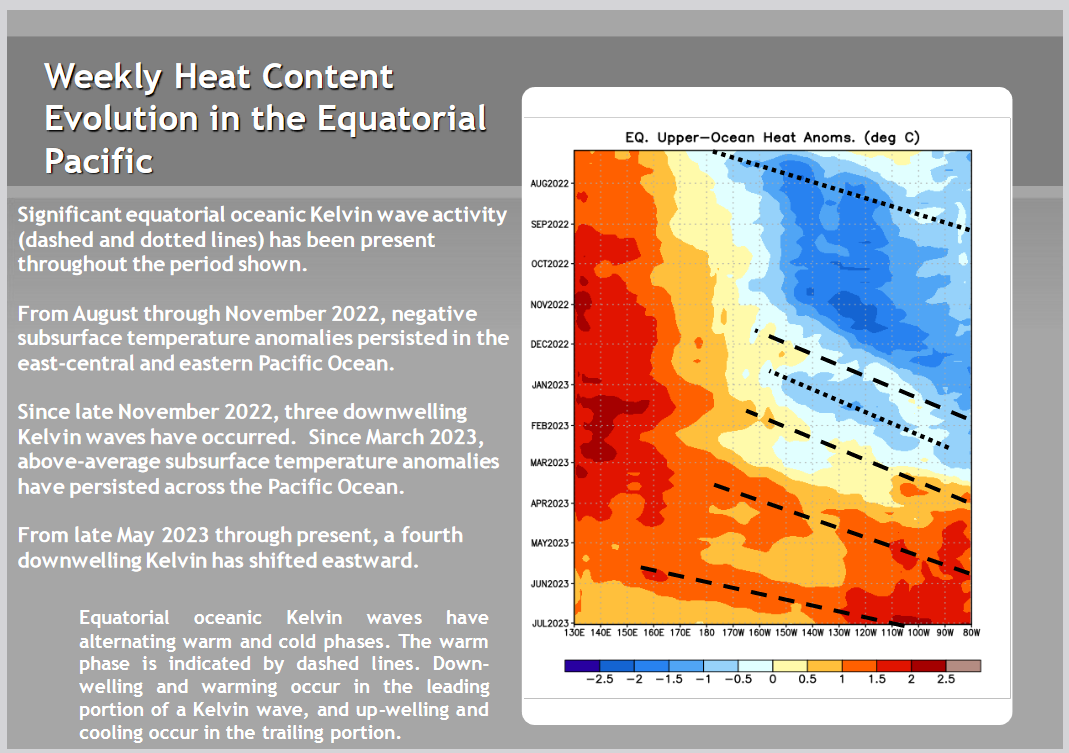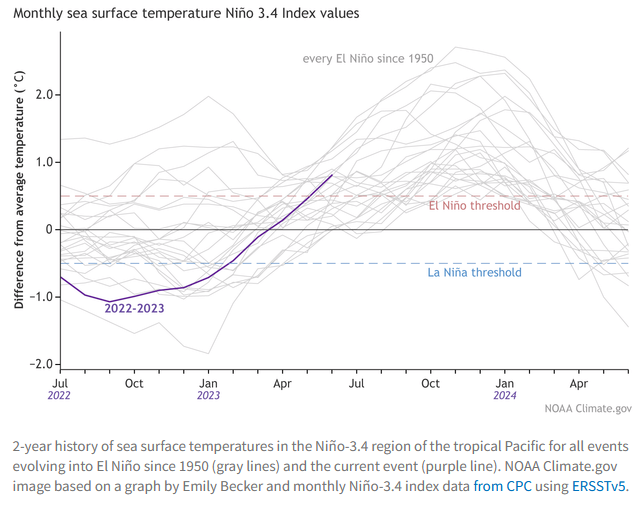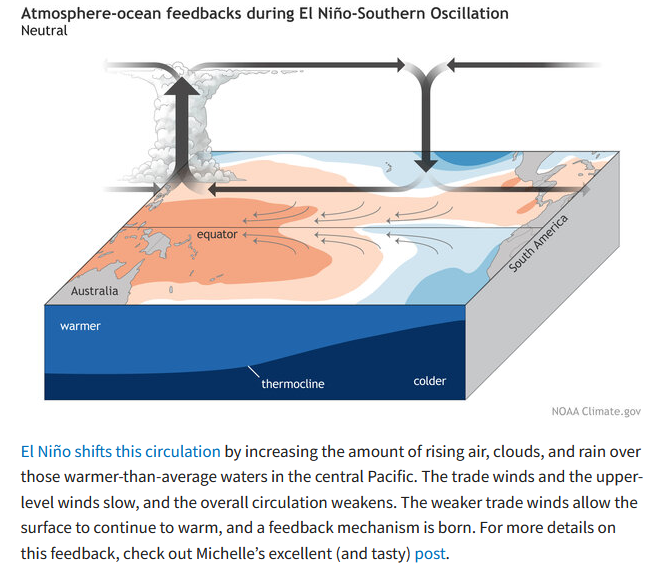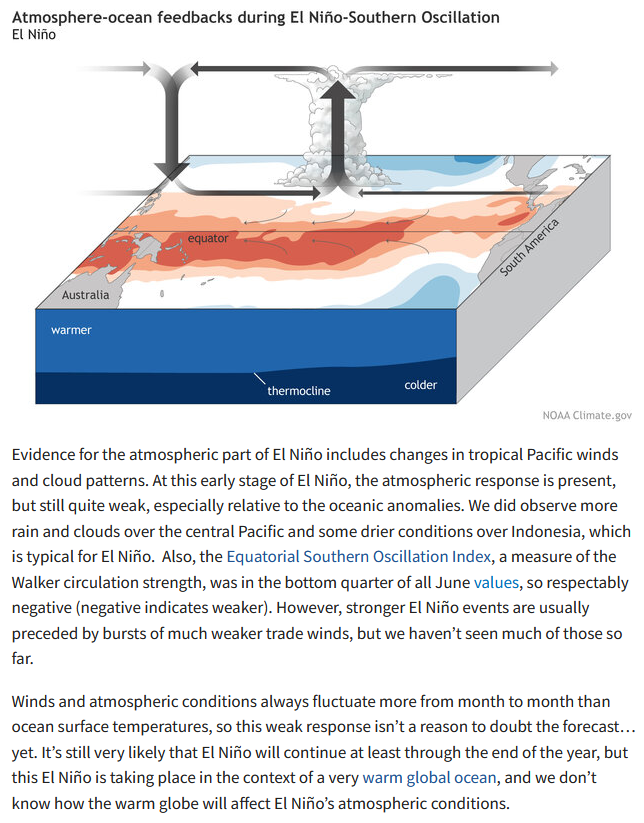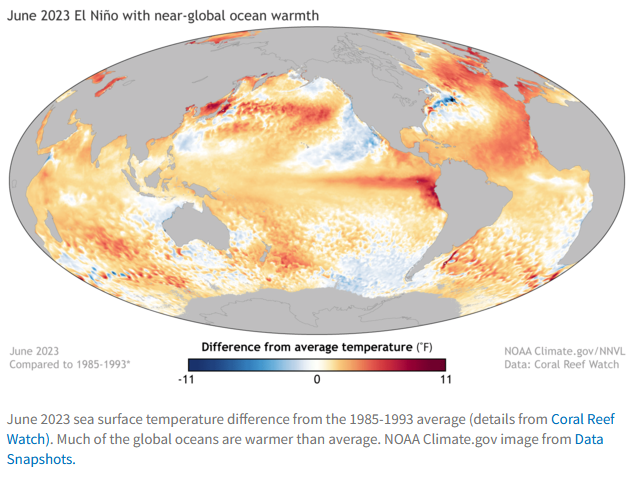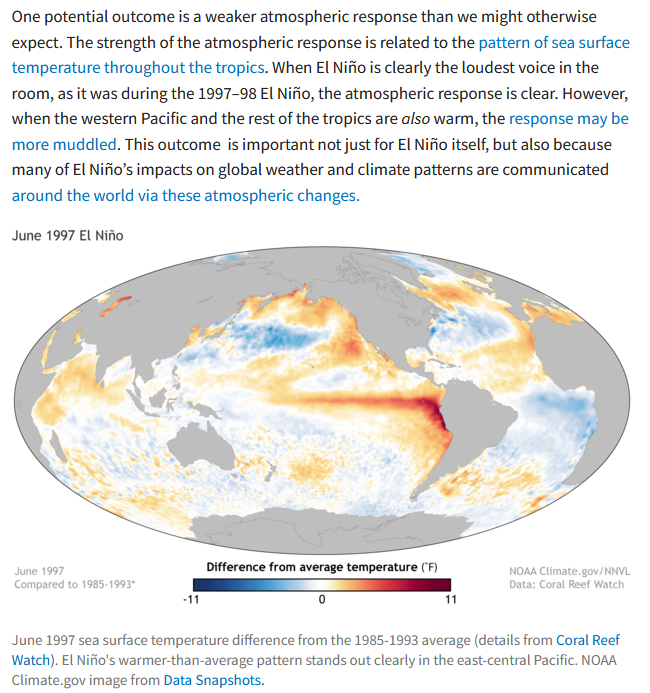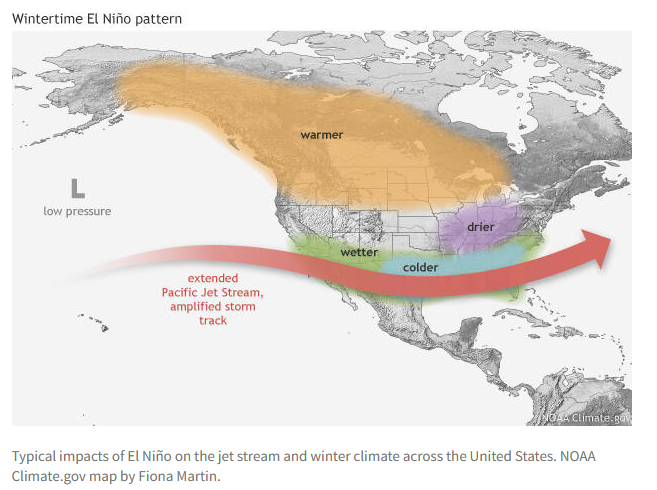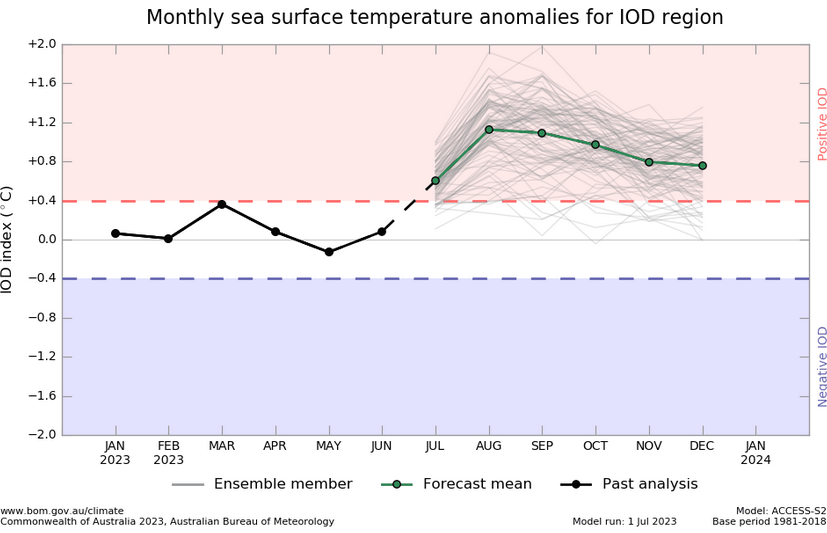On the second Thursday of every month, NOAA issues its analysis of the status of ENSO. This includes determining the Alert System Status. NOAA again describes their Report as “ENSO Alert System Status: El Nino Watch”
There is not much doubt that we have an El Nino. How long it lasts and its strength remains to be seen.
From the NOAA Analysis:
CLIMATE PREDICTION CENTER ENSO DISCUSSION
| The second paragraph is what is important:
“The most recent IRI plume indicates El Niño will persist through the Northern Hemisphere winter 2023-24. Forecasters favor continued growth of El Niño through the fall, peaking this winter with moderate-to-strong intensity (81% chance of November-January Niño-3.4 ≥1.0C). An event that becomes “historically strong” (seasonally averaged Niño-3.4 ≥ 2.0C), rivaling the winters of 1997-98 or 2015-16, has an approximately 1 in 5 chance. In summary, there is a greater than 90% chance that El Niño will continue through the Northern Hemisphere winter. |
We now provide additional detail.
CPC Probability Distribution
Here are the new forecast probabilities. This information in the past has been released twice a month and the first release is based on a survey of Meteorologists, the second is based on model results. The probabilities are for three-month periods e.g. JJA stands for June/July/August. The first forecast forecast is used to develop the Seasonal Outlook which will be issued next Thursday so that is what I am focusing on.
Here is the current release of the probabilities: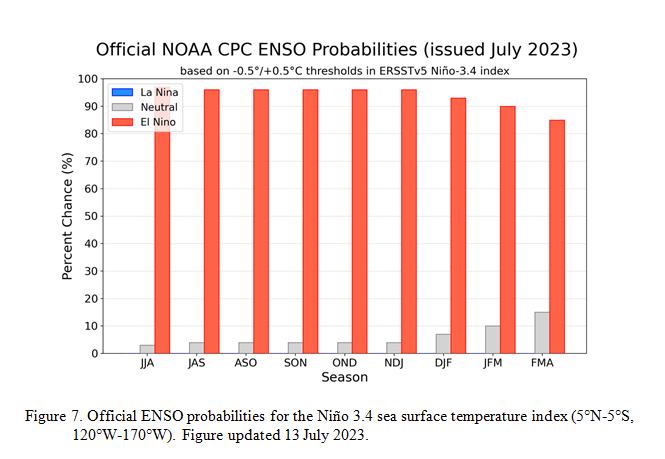
| You can clearly see The forecast does not extend beyond FMA 2024 but one does see a slight tail-off in the probabilities for El Nino conditions in the Eastern Pacific after the winter season. |
| Announcement: We now publish a daily weather report that addresses U.S. weather near-term through four Fridays and a five-day Global weather forecast. You can find it at econcurrents.com. To return to this article just hit the return arrow at the upper left corner of your screen |
And here is the forecast from last month (Actually this one is from two months ago).

And the prior month
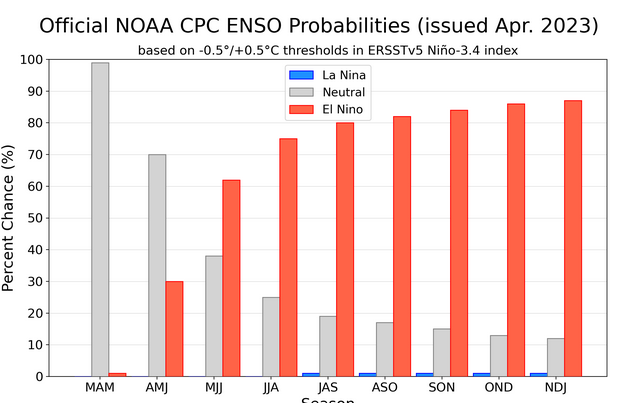
And back in January when we saw the possibility for El Nino in the distance.
| In January we had a hint that we might have an El Nino. Now El Nino has arrived and the real question is how strong will it be. |
What Does the NOAA Proprietary ENSO Model Forecast?
| This model shows the scatter in the forecasts but the scatter is much less than last month. The dark dashed line is the mean of the ensemble forecasts. If you want to see an updated version you can view an updated version by clicking HERE. But the current reading is what is relevant in terms of the NOAA ENSO analysis released on May 11, 2023. It does seem to show a peak in OND and a slight tailing off after that. Something to watch. |
View of other Meteorological Agencies
They all agree that there will be an El Nino but there is a range of opinions on how strong it will be and I do not have forecasts of that out far enough in the future to be helpful at this point in time.
Looking at Actual Current Conditions.
NOAA reports some derived data that describes the current situation and a forecast. But what if we want to form our own opinion? After all, meteorologists are looking at the actual current situation and making predictions.
This shows the current actual situation for the surface of oceans. To update this graphic click HERE.
| You can already see the warm tongue of water extending from Ecuador and Peru. The pattern off the U.S. West Coast is confusing. The warm water off of West Africa might be important re the Hurricane Season. |
Where is ENSO Measured?
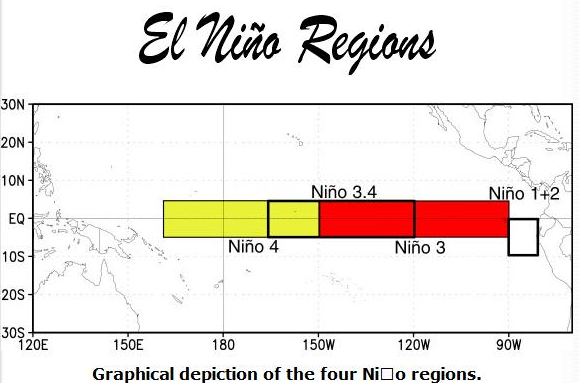
–
| You can mentally superimpose the Nino 3.4 area shown encompassing part of the yellow and part of the red areas in the above map and you can see that it is pretty much neutral in the Nino 3.4 area especially South of the Equator. However, in the Nino 3 and Nino 1+2 Areas, the water is very warm.-But it is still under the El Nino Threshold in Nino 3.4 but that will probably change very soon as the warm tongue extends to the west. From the NOAA Diagnostic Discussion: “Low-level wind anomalies were westerly during mid-April before switching back to easterly by the end of the month”. |
Putting the historical information in motion. Updates can be found HERE. but should not be needed.
Now we look at the below surface temperature anomalies. Mapping the details. (Cross-Section along the Equator). The data is a five-day average centered on the date shown.
| There is a lot of warm water on the surface and below it. |
–
Here is another way of looking at it.
| Here we integrate the temperature of the layers to get the total heat anomaly for the different layers down to 300 meters. You can see how it went from colder than -0.5C to between -.05 C and +o.5C to now above +0.5C. But it is the surface temperature that counts and the area measured here is a little different than the Nino 3.4 area. So we can not translate this into weather but it shows how the structure of the subsurface has changed, I could probably provide a more complete explanation of the interconnection of the surface to the subsurface (direction of causality) during the different phases of ENSO but this provides a useful metric to describe how things have changed. |
Kelvin Wave: One explanation of the recent rapid change in the situation are Oceanic Kelvin Waves.
| This type of Kelvin Wave is one of the mechanisms for the warm water in the IndoPacific WarmPool to move to the east. This is a Hovmöller diagram It is sort of like a plotter graph as it shows the earlier time periods at the top and the most recent at the bottom. It is used a lot in meteorology. Notice the three dashed lines towards the bottom. It is showing that there was a weak downwelling Kelvin Wave that was not followed by an upwelling phase but instead by a subsequent and stronger downwelling phase and then another one. That broke the back of the La Nina and has continued to strengthen the El Nino. The MJO may have contributed to initiating the Kelvin Wave. Three consecutive years of La Nina caused the IndoPacific WarmPool to increase and begin to spread out. This makes it easier for this kind of Kelvin Wave to get started. That is why no one phase of ENSO can last indefinitely but it was a surprise to have three La Nina Winters in a row. |
Are the changes sufficient to move not just from La Nina to ENSO Neutral but all the way to El Nino?
We need to look at additional information.
I abbreviated this section because it seems that we can be confident that we have left or will soon leave ENSO Neutral conditions in terms of the sea surface temperatures in the Nino 3.4 measurement area but is the atmosphere responding?
| The SOI had been falling which is consistent with the end of La Nina. But what is going on now? This is something we need to watch carefully. It is not confirming the El Nino. |
What are other Meteorological Agencies Predicting.
Here is the Australian BOM forecast,
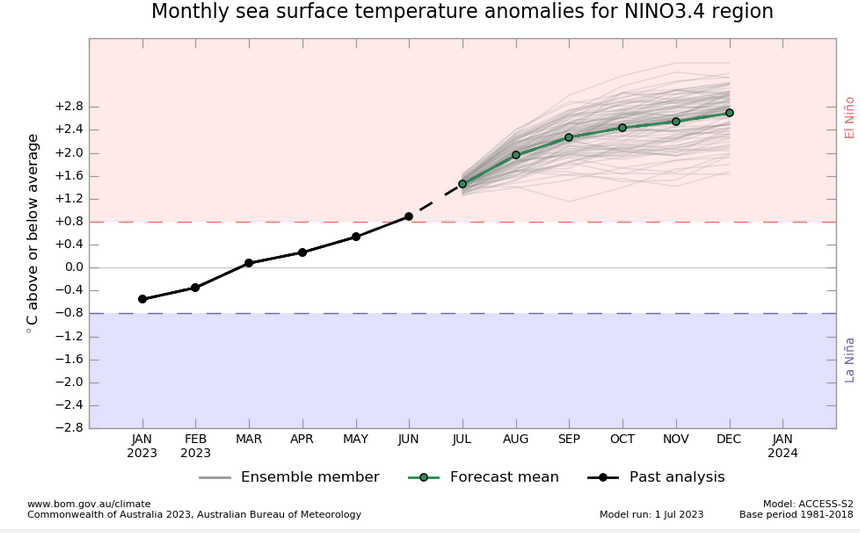
And here are some others provided by the BOM with their forecasts for the Nino 3.4 Index n December of 2023.
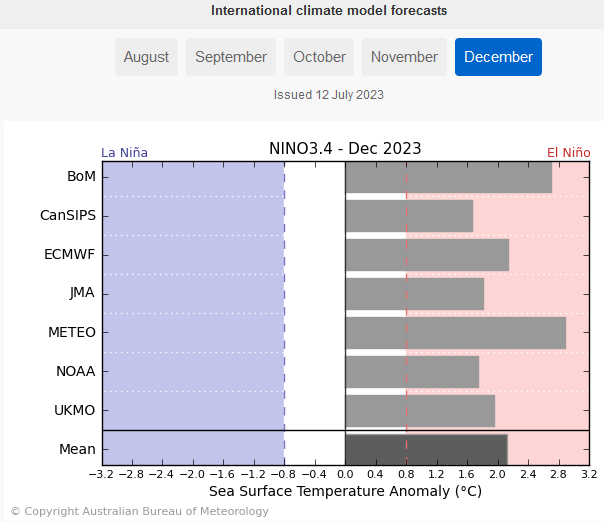
Interesting article from the NOAA ENSO Blog

You can read the article by clicking HERE
Here are some graphics from the blog article.
| Based on history, the strength of this El Nino could range from weak to very strong. |
| This is the typical atmospheric pattern for an El Nino. This describes what is called the Walker Circulation. |
| Notice she talks about the Atmospheric response being weak which we noticed earlier in this article. The second paragraph is very intriguing. |
| This continues the discussion about how the ENSO Cycle might be influenced by Global Warming. |
| Emily Becker continues. |
| The above is from one model. The BOM set of models shows some higher valued for the Nino 3.4 Index. |
| This is the standard winter El Nino pattern but it can vary a bit and Emily Becker suggests it migh vary even more than historically. |
What about the Indian Ocean Dipole (IOD)?
| The index is calculated as the monthly difference between the western (10°S-10°N, 50°-70°E) (WTIO) and eastern Indian Ocean (10°S-0°, 90°-108°E) (SETIO) sea surface temperature departures from average. |

Australia BOM IOD forecast
And looking at some other models as well
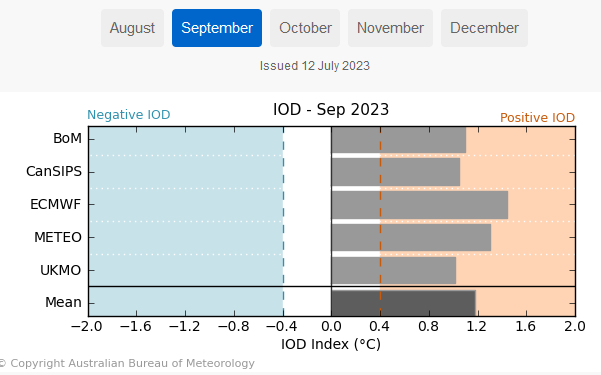
| IOD is now positive. It may be bad news for Australia and wet news for India. It will impact all nations where their weather is impacted by the Indian Ocean. But the impacts will vary based on latitude. We should see this in the JAMSTEC World forecast which I plan to publish on Sunday. |
| I hope you found this article interesting and useful. |

